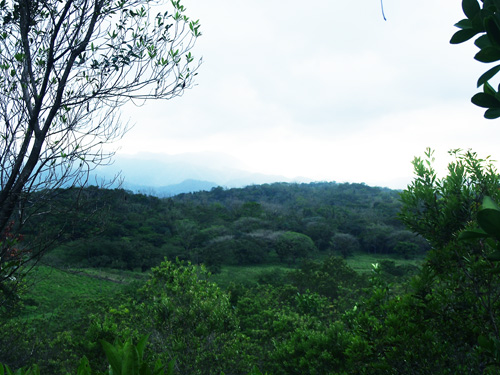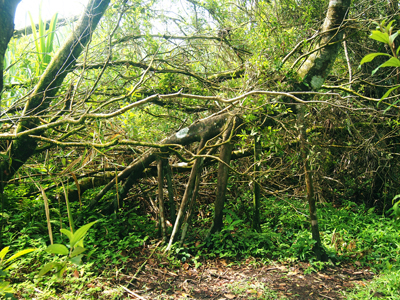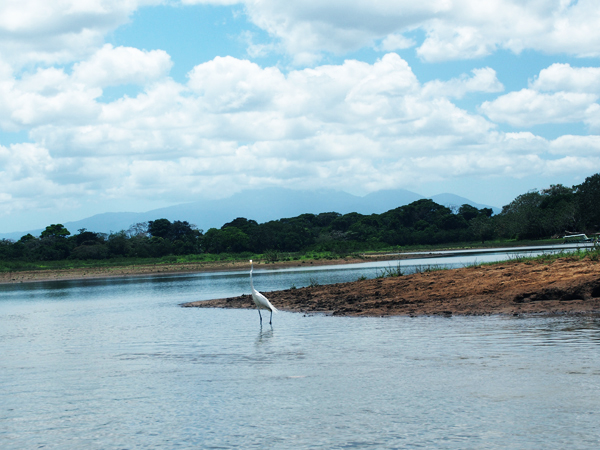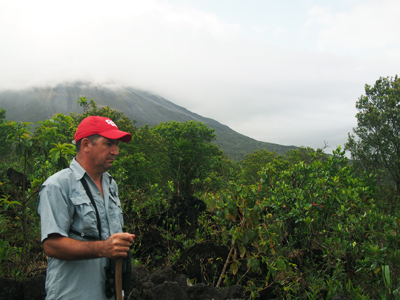Engaging Getaways and Venues for:
Costa Rica/Guanacaste: La Fortuna
The Highlights: A picture-perfect volcano (in resting state), stunning tropical rainforests in a temperate climate, unspoiled exotic scenery, hikes, cycling and water sports, hot springs, one of the world’s most spectacular jungle canopy walks.
Other Places Nearby: The magical rural village of Cano Negro in the heart of a national wildlife refuge.
Meetings Options: Multiple locations for small destination weddings, reunions, corporate retreats and incentive trips.
.jpg)
Not often can one say that people gave their lives for the benefit of local tourism, but that is in fact the case with the nearly 80 people who died when the Arenal volcano in north central Costa Rico exploded in 1968. It devastated two small communities with a tremendous rain of molten lava and the even more deadly pyro toxic gases released in the great eruption. One tiny community perished beneath the molten lava that fell back to earth after the catastrophic eruption; another downwind of the volcano was felled by the deadly gases carried by the wind.
But that was by no means the end of the story for this quiet, remote farming region known for its fecundity due to its mild year-round climate, fertile volcanic soils and ample rain.
Today tourists come by the busload to enjoy the region’s scenery, rainforests, ziplines, white water rafting, etc., so it’s not as easy as one might hope to escape the crowds during the peak winter season. This short escape takes you to places where you can enjoy the serenity and beauty that attracted only a few backpackers and other adventurers until the Arenal volcanic eruption put it on the map in the late 1960s. The world-renowned flora and fauna, geology and geography make this worth the trip, but to know the place is also to understand it’s curious transformation from farming center to worldwide tourism attraction.
Once a Sleepy Farm Town
Up until the time of the eruption, the tiny town of La Fortuna, now the area’s tourism center, was a small but successful regional farming community due to the high quality of the soil. Itself escaping the worst effects of the eruption, village life probably would have continued unchanged. Before the eruption, the only tourists consisted of a few adventuresome backpackers who came for the spectacular scenery, the ability to easily hike on the plentiful dirt roads and paths used by locals, and for the charm of the Costa Rican people, known as Ticos, who relish a peaceful way of life expressed in a common, multipurpose greeting or goodbye: “Pura Vida,” literally Pure Life.
But La Fortuna’s tranquility was not to last. For in 1968 the mighty Arenal volcano didn’t just release her fury in one single blow. She continued to erupt with less vehemence, providing near continuous spectacular displays of fire and smoke, particularly impressive at night. Thankfully, the steady easterly trade winds that create the plentiful rains during the summer blew the smoke away from the village.

Gradually, word got out about the spectacular natural fireworks. A small but growing number of intrepid travelers found their way to La Fortuna on Costa Rica’s legendarily bumpy dirt roads, often with the help of enterprising tourism companies in the capital city of San Jose, to witness a regular display of awe-inspiring magnitude. Visitors relished from a safe distance what were described as enormous booms with the roar of dozens of jumbo jets, a great shaking beneath one’s feet, huge explosions of flame bursting from the top of the volcano—a perfect cone standing about 5,000 feet in the air; a towering Mordor of a mountain no more than 40 years old.
As the volcano continued its awesome performance, more travelers came, and soon there began to spring up simple bed and breakfasts, then inns, hotels and beautiful resorts, the most expensive of which had rooms perfectly situated with a direct view of all of the action, framed by exotic jungle vegetation out of a scene from Jurassic Park. Wherever one stayed, it was just a short drive to enjoy great views in most cases safely away from the smoke, gas and ash, and mostly out of the way of the next eruption, based on an analysis of fissures and faults emanating from the fast-growing mountain.
A Trifecta of Fortune
Among the most beautifully situated of these resorts, and certainly luxurious but in an understated way, was Lost Iguanos Lodge, which is perched on a hillside with near perfect views of Arenal. This beautiful small hotel, founded by an American, exemplified the explosion of growth that was in effect a gold rush for La Fortuna, as more and more people came to see the mountain erupt. Adding to the growth, the emergence of eco-tourism in the 1970s enhanced the appeal of the region with its tropical rainforests, ample wildlife, ziplining, rafting and other pursuits, not to mention the laid back Costa Rican culture, making it one of the safest destinations in Latin America. Lastly, the building of the nearby Arenal dam for hydroelectric power required better road access, which in turn brought even more visitors. That effort created an enormous and breathtakingly scenic man-made lake covering one of the tiny communities destroyed by the volcano’s toxic gas, and now provides power through a hydroelectric plant on its western end.

Today the dam offers great views of the lake, as well as a display of the area’s young people, who come on weekends, holidays and evenings to barbecue and meet with friends, often causing traffic jams on the narrow bridge unmolested by the authorities. Pura Vida indeed. To build the dam, roads to the area had to be improved, so it now takes only about 3 ½ hours from San Jose and 2 ½ hours from the international airport in Liberia by car. (Note: The roads are still not great; the distance is only 80-90 miles, and the narrow lanes, poor road signs and lack of shoulders and streetlights make it inadvisable to drive after nightfall.)
Over the next 40 years, an entire industry of hotels, restaurants, transportation services, tours, ziplines, parks and ATV tracks created thousands of jobs, turning La Fortuna into a small, bustling town and attracting employees and their families from around the country and beyond.
While gazing at the region’s wonders, it’s easy to overlook a story almost as compelling as the natural surroundings: the effect of this Gold Rush on the locals. The area began to attract entrepreneurs, professionals and the laborers and hospitality workers who would build the hotels and provide all of the services required by the hotels, restaurants and tour operators. Among this group were people like Johnny Calderon—it is common for Ticos to give their children English names—whose father was an opportunistic laborer, hunter and forager in a village several hours away. Johnny now owns one of the tour operators in La Fortuna recommended by local hotels, offering individuals, couples and groups guides and tours to the area’s nature trails, white water rafting, kayaking and other regional attractions. Today, Johnny (or Paloma, as his friends call him) runs a business that is a microcosm of how the volcano affected not only La Fortuna, but the people who make it happen for all the visitors to the area.
Having grown up with a poor but multi-faceted and enterprising father with whom he is still close, Johnny lived not far from a river that attracted some of the early adventure travelers to the region. They came to Costa Rica before the time of the eruption for its pristine, roaring rapids fed by reliable rains and for the beauty of the jungle valleys through which they flow. He recalls as a boy being enraptured by the wild water and through good fortune was able to get some work with a local guide company, where he began to learn the skills of white-water rafting, and which eventually presented an opportunity to take an intensive English training program. This in turn led to a summer job working the waterways of the western United States for companies that hired skilled overseas crewmen to help run the rivers during the peak rafting season, after which he would return home to Costa Rica.
“Most Costa Ricans don’t leave,” he explains. “We are too happy here. If we leave, we often come back.” This is confirmed by CIA statistics: Costa Rica has one of the lowest emigration rates in Latin America—half the rate of Mexico, for example. After the volcano erupted, Johnny got jobs running tours in La Fortuna for people searching for other activities during the day, moved to La Fortuna, got married and started building his small family in the shadow and prosperity of the volcano that would not stop giving.
When the Show Stopped
Two terrible events—one of them economic, the other natural—conspired to put a screeching halt to the easy life. First came the great recession that began in 2008, whose impact on tourism continued to mount in the following year, but then came the greatest blow of all: Suddenly, in 2010, Arenal stopped erupting. At first, no one was quite sure what was happening, and people continued to hope it was just a brief respite, but soon some competitive destinations within Costa Rica began to question if the action was over and suggested there was no longer any reason to make the drive up to Arenal. The volcano remained quiet. According to locals in the tourism industry, the one-two punch caused tourism to plummet, and many businesses with too much debt went under.
Fortunately, the interest in eco-tourism—combined with the area’s stunning beauty and the diversity of lodging and attractions developed during the tourism boom—were enough to bring people back when the economy recovered, even without the volcano’s fireworks. The hot springs continue to provide a refreshing taste of the power of the mountain, and visitors have returned, not only from the U.S., but from Europe, Israel and Asia, as well as other parts of Latin America, to see the beautiful volcano, the car-stopping scenery, jungle rainforests and to enjoy the well-developed infrastructure offering days of various activities depending on your tastes.

An Escape to the True Cano Negro
For a true Costa Rican experience, go to the Cano Negro few visitors ever see. This tiny village in the center of the Cano Negro Wildlife Preserve is a paradise for those who wish to experience the wildlife, scenery and a taste of unspoiled Costa Rican village life. This is not the place most tours take people to see the wildlife in the area around the Cano Negro Preserve. Most tours take groups to the Rio Frios and the town of Los Chiles, which are not actually in the Preserve and which often are jammed with tourists. That’s about a 90-minute drive from La Fortuna on paved roads, making for a popular day trip. It’s an extra 30 minutes or more of dirt road to go on to the tiny village of Cano Negro, alive with birds and other wildlife, as well as rural people of Costa Rica—and without the busloads of tourists.
There is no website for the tiny village; just about the only source is Tripadvisor, which has only a little information. There is a local boat tour in Cano Negro that people with a car can book on their own at a considerable savings over the tours in La Fortuna. It includes a three-hour trip with beverages on the channels, lagoons and lakes filled with varying degrees of water depending on the season, and almost always rich in wildlife a beautiful scenes of rural Tico life.The local tour operators offer covered motor boat tours of the intricate waterways and lagoons in a park that won’t disappoint those seeking plentiful wildlife from howler monkeys, all types of birds, turtles, caimans and crocodiles, not to mention unsurpassed scenes of rural life in Costa Rica, since people live and work in the Preserve as well. Just don’t expect to get a guide who is fluent in English if you book this directly, and you’ll have to make the drive on your own, preferably with GPS just to be sure. The tiny village has a few rustic inns and a couple of Tico restaurants where you can enjoy fish taken from the local waters. If you prefer to be driven and want an English-speaking guide, you can book through Flowtrips.com or email Johnny Calderon. He recommended this Short Escape to us and has ideas of others he’d like to share of more authentic Costa Rican experiences.

If you rent a car, make sure you call the local tour office below in advance to reserve a tour. Rosi Arguedas speaks a little English. In the local restaurants, try the fish prepared as the chef recommends. It will generally be served as a Casado, a traditional lunch or dinner of fish, beef, chicken, or pork, described in Dining.
To book a tour directly in Cano Negro, you can email paraisotropicalcn@hotmail.com, or call 506 2471-1621; cell 506 8823-4026. One of the owners, Rosi Arguedas, speaks English, and will suggest different tour options as well as local rustic dining. Her establishment offers delicious local food, and there are a couple of other small restaurants in the village.
For those who’d like to have a true Costa Rican experience, spend the night. The area has a few local hotels here of varying degrees of comfort, all rustic and located deep in the countryside. Hotel de Campo is probably the most comfortable hotel in the area and popular with bird-watchers and other nature lovers. It offers a number of cabins with air conditioning on beautiful grounds near the river and also has a small pool.
The Kingfisher is more rustic, but the cabins are clean, comfortable and air conditioned.